Bayer R.G. Mechanical Wear Fundamentals and Testing, Revised and Expanded
Подождите немного. Документ загружается.

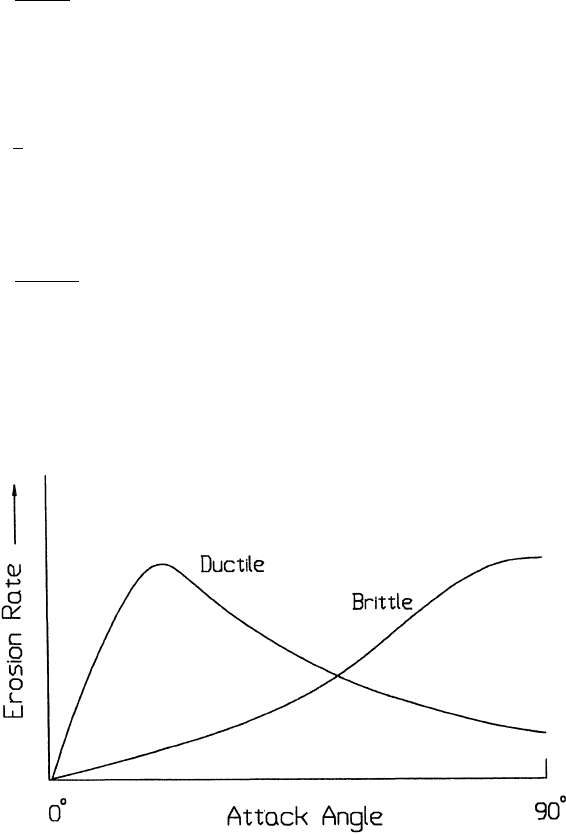
Because of this difference, it is necessary to modify the equation for single-cycle wear for
applicability to erosion situations. A simple way of extending this equation to particle ero-
sion is as follo ws (70).
The equation for single-cycle wear, Eq. (3.20), relates wear to the normal load. The
first step in the derivation is to convert from normal load to frictional load, F. This is done
by means of Amontons’ Law, Eq. (1.1), namely,
F ¼ mP ð3:98Þ
Equation (3.20) then becomes
V ¼
KðFxÞ
mp
ð3:99Þ
where the product Fx represents the energy dissipated by sliding during the impact.
The total kinetic energy of a particle stream of total mass, M, and particle velocity, n ,is
given by
E ¼
1
2
Mv
2
ð3:100Þ
As a result of the impact with the surface, a fraction, b, of the energy is dissipated in the
form of wear. Equating this loss to Fx, the following expression is obtained:
V ¼
KbMv
2
2mp
ð3:101Þ
In erosion, it has been established that the angle at which the stream impi nges the
surface influences the rate at which material is removed from the surface and that this
dependency is also influenced by the nature of the wearing material (70,159). This is shown
in Fig. 3.80. Such a dependency is to be anticipated. This can be seen by considering the
Figure 3.80 The effect of attack angle on erosion rates of ductile and brittle materials. (From Ref.
194.)
Copyright 2004 by Marcel Dekker, Inc. All Rights Reserved.

impact of a single particle with a surface. The angle determines the relative magnitude of
the two velocity components of the impact, namely the component normal to the surface
and the one parallel to the surface. The normal component will determine how long the
impact will last, that is, the contact time, t
c
, and the load. The product of t
c
and the tan-
gential velocity component determine the amount of sliding that takes place. The tangen-
tial velocity component also provides a shear loading to the surface, which is in addition to
the normal load related to the normal component of the velocity. Therefore, as the angle
changes, the amount of sliding that takes place also changes, as does the nature and mag-
nitude of the stress system. Both of these aspects influence the way a material wears. These
changes would also imply that different types of materials would exhibit different angular
dependencies as well.
As can be seen in Fig. 3.80, the effect of angle on erosion rate is significantly different
for ductile and brittle materials. W ith brittle material, the maximum erosion rate occurs at
normal impact, while for ductile material s it occurs at some intermediate and generally
much smaller angle. These differences can be understood in terms of the predominant
modes of damage associated with these types of materials.
As discussed in Sec. 3.3, brittle fracture tends to increase the amount of wear over
that caused by displacement, that is by cutting and plowing. As indicated in Fig. 3.20, this
could be by as much as 10 . As a general rule, brittle materials are more likely to fracture
under normal impact conditions, that is, impacting velocity perpendicular to the surface,
than ductile materials. Consequently, as the erosive condition moves from a more grazing
situation to a more normal impact, brittle materials would experience a greater tendency
to experience brittle fracture, which would tend to increasingly mask the ductile or cutting
contributions. For brittle materials, the erosion rate would then be expected to mono-
tonically increase with the angle.
For ductile materials, cutting and plowing are the predominant modes and fracture
is negligible. The model for single-cycle deformation indicates that the wear due to cutting
and plowing is proportional to the product of load and distance (see Eq. (3.20)). Since load
increases with angle and sliding decreases with angle, an intermediate angle should exist
where the product of the two is maximum.
This angular dependency is contained in b in Eq. (3.101). Assuming that b can be
separated into an angular factor, F, and a factor independ ent of angle, b
0
, and combining
several of the material-sensitive parameters and num erical factors into one, K
e
, the follow-
ing expression can be obtained:
V ¼
K
e
FMv
2
p
ð3:102Þ
Examining this equation for erosive-wear volume, it can be seen that it does not provide
an explicit dependency on duration or exposure. However, such a dependency is implicitly
contained in M, the total mass of particles. If Q is particle mass per unit time, then M is
Qt, where t is the time of exposure to the particle stream. Including this into Eq. (3.102),
the following form is obta ined for particle erosion:
V ¼
K
e
Fv
2
Qt
p
ð3:103Þ
Another variation of Eq. (3.102) is frequently encountered in the literature. Compar-
ison of erosive wear situations and resistance to erosion is often done in terms of the rela-
tive amount of material removed from the surface to the amount of abrasive particle
Copyright 2004 by Marcel Dekker, Inc. All Rights Reserved.

causing the wear (160). With d as the density of the particles, the following equation can be
obtained:
V
V
a
¼
K
e
dFv
2
p
ð3:104Þ
where V
a
is the volume of abrasive used to produce the wear.
A compilation of values for the erosive wear coefficient, K
e
, is given in Table 3.9.
Comparing these values to the values for wear coefficients for abrasion, Table 3.8, it
can been seen that they are very similar. This is consistent with the underlying hypothesis
that the same wear mechanisms occur in both situations.
Equations for solid particle erosion, which are equivalent to Eqs. (3.94) and (3.96)
for abrasion, can be developed in a similar manner. These are:
V ¼ K
e
Fv
2
Qt ð3:105Þ
V ¼
K
e
Fv
2
Qt
p
n
ð3:106Þ
Equation (3.106) applies when the surface is harder than the particles. In general, the ero-
sive wear coefficients in these equations for particle erosion have similar sensitivities to
their counterparts for abrasion , that is, they can be affected by characteristics of the abra-
sives, type of material or simply material, atmosphere, and fluid media (161).
In controlling abrasive wear, the most significant feature is that once the wearing
surface becomes harde r than the abrasive, wear rates are dramatically reduced. The effect
here is equivalent to the use of lubricants to control adhesive wear. Both give orders-of-
magnitude improvement. Further discussion and examples of abrasion and particle ero-
sion can be found in Chapter 9, and in Chapters 5 and 7 of Engineering Design for Wear:
Second Edition, Revised and Expanded.
3.9. WEAR MAPS
Wear maps are graphical techniques used to characterize various aspect of wear behavior in
terms of independent operational parameters of the tribosystem, such as speed and load.
Various forms of wear maps are typically used to identify ranges of these parameters with
wear mechanisms, wear rates, and acceptable operating conditions. Generally, they are two-
dimensional graphs where the axes are the independ ent operati onal parameters. Curves are
plotted on these grap hs to separate regions of different wear behavior and to represent
conditions of constant wear rate. In addition to the generic name of wear map such plots
are also referred to as wear mechanism maps, wastage maps, material performance maps,
wear transition maps, wear rate maps, and contour wear maps, depending on their nature
and use. Examples of different types of wear maps are shown in Figs. 3.81–3.84 and
3.86–3.90. Figures 3.81–3.84 are examples of ones used for sliding wear; Figs. 3.86
and 3.87, for tool wear; and Figs. 3.88, 3.89, and 3.90, for solid particle erosion. While
maps of these types can be developed on a purely theoretical or experimental basis, most
are primarily empirical-based. However, theoretical considerations are often involved to
facilitate the construction and to minimize the amount of data required (106,109,162–
170).
Copyright 2004 by Marcel Dekker, Inc. All Rights Reserved.
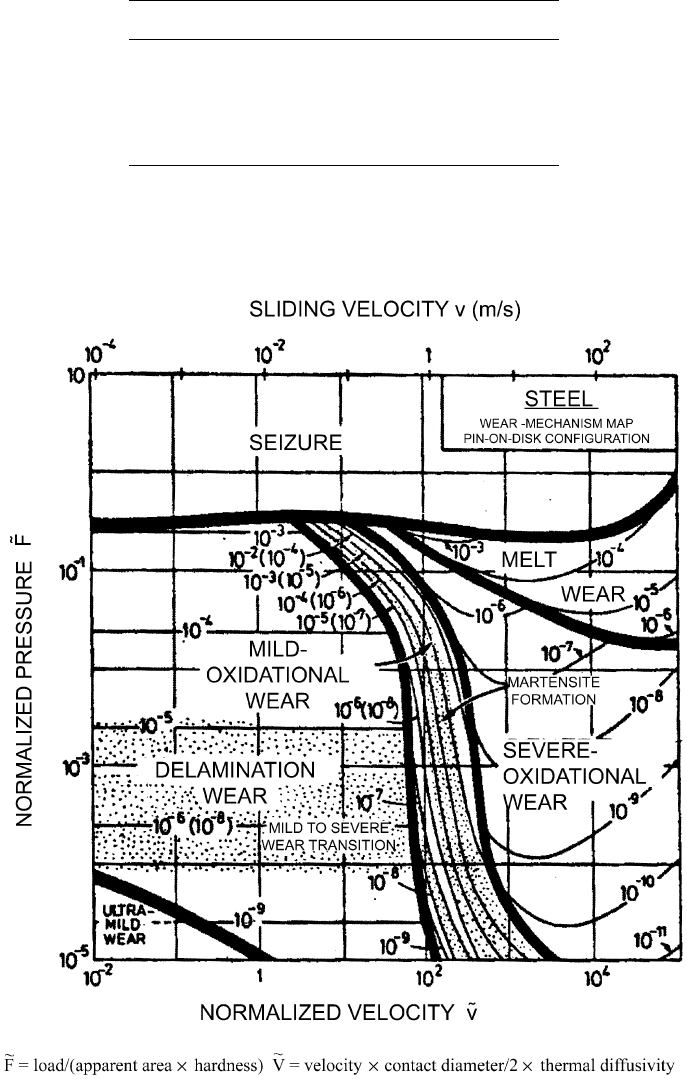
Table 3.9 K
e
Values for Erosion
Target material K
e
Soft steel 8 10
3
–4 10
2
Steel 1 10
2
–8 10
2
Hard steel 1 10
2
–1 10
1
Aluminum 5 10
3
– 1.5 10
2
Copper 3 10
3
– 1.3 10
2
Figure 3.81 Wear map developed for unlubricated sliding between self-meted steel. (From Ref.
109, reprinted with permission from Elsevier Science Publishers.)
Copyright 2004 by Marcel Dekker, Inc. All Rights Reserved.
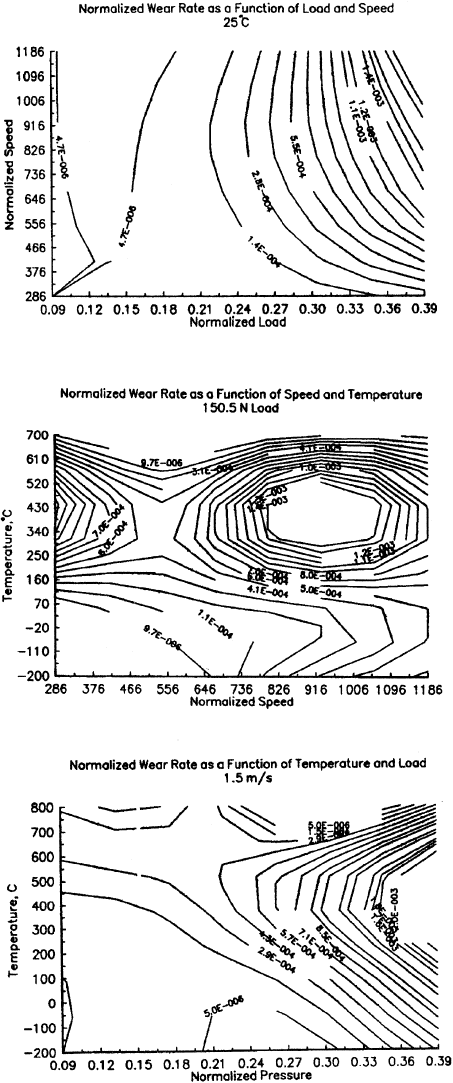
Figure 3.82 Wear mechanisms maps used to characterize the unlubricated sliding wear behavior of
self-mated 440C stainless steel. (From Ref. 163, reprinted with permission from Elsevier Sequoia
S.A.)
Copyright 2004 by Marcel Dekker, Inc. All Rights Reserved.
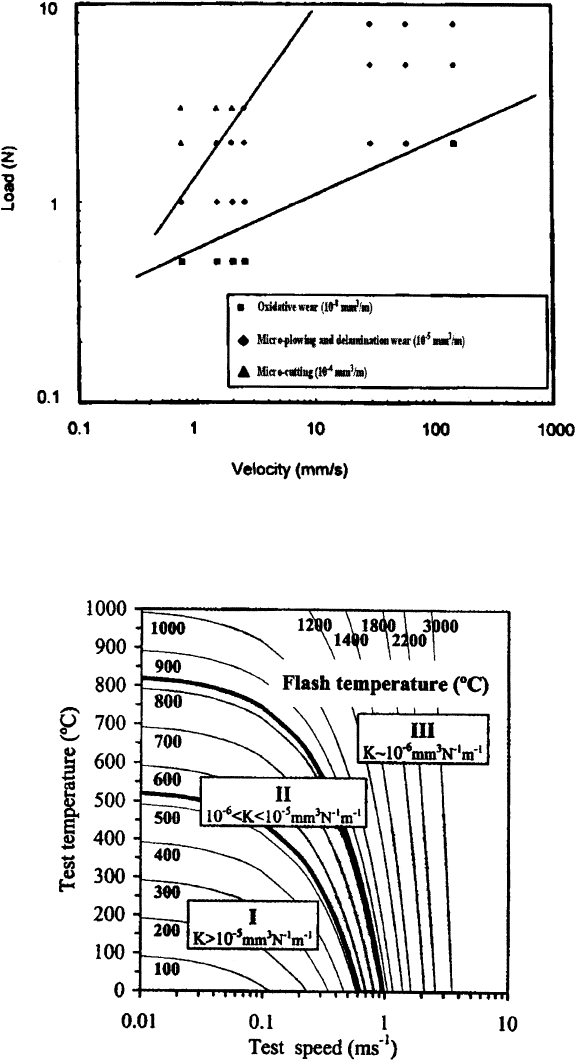
Figure 3.83 Wear map characterzing the wear behavior of Cr ion-implanted iron sliding against a
hard steel counterface and lubricated with liquid paraffin. (From Ref. 168, reprinted with permission
from Elsevier Sequoia S.A.)
Figure 3.84 Example of wear maps used to characterize the unlubricated wear behaviour of silicon
nitride ceramics sliding against steel. These maps are referred to as wear transition maps and show
the transition in wear behavior of the ceramic as function of ambient temperature and speed. (From
Ref. 136, reprinted with permission from Elsevier Sequoia S.A.)
Copyright 2004 by Marcel Dekker, Inc. All Rights Reserved.
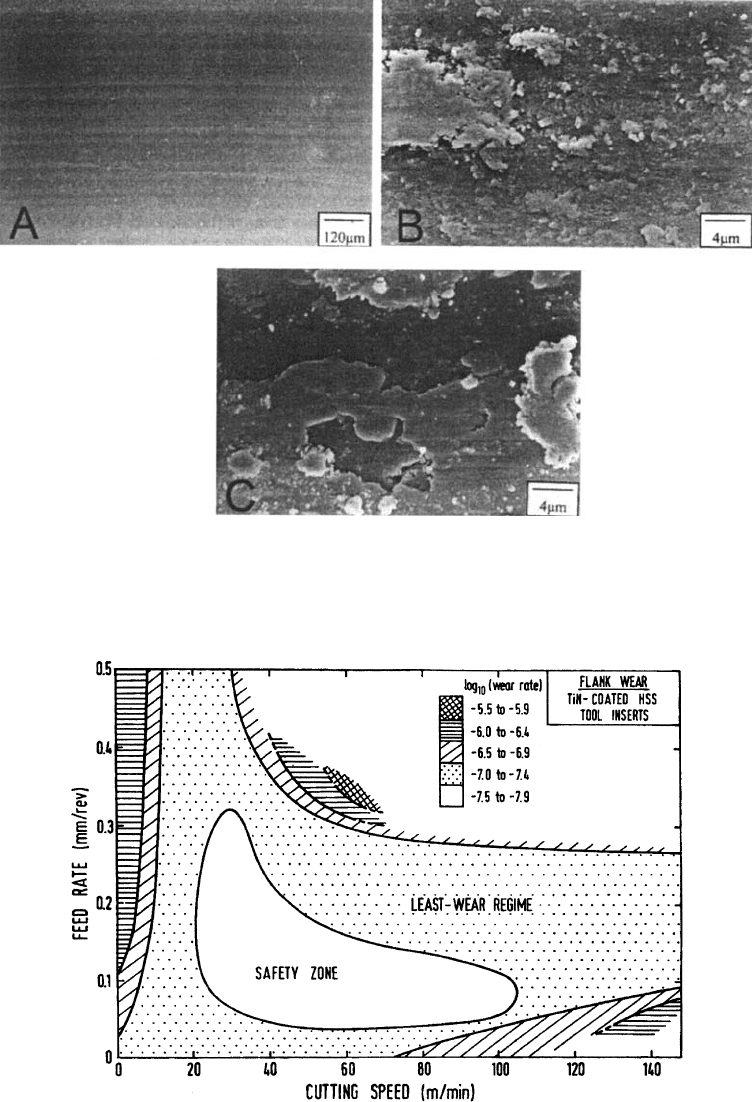
Figure 3.85 Examples of wear scars on silicon nitride ceramics in the different regions identified in
wear transition maps, such as illustrated in Fig. 3.84. ‘‘A’’ is for 22
C and 0.5 m=s; ‘‘B’’ is for 200
C
and 0.5 m=s; ‘‘C’’ is for 22
C and 3.5 m=s. (From Ref. 136, reprinted with permission from Elsevier
Sequoia S.A.)
Figure 3.86 Wear map for flank wear of Ti-N coated steel tool. Map is used to identify acceptable
regions of operation. (From Ref. 167, reprinted with permission from Elsevier Sequoia S.A.)
Copyright 2004 by Marcel Dekker, Inc. All Rights Reserved.
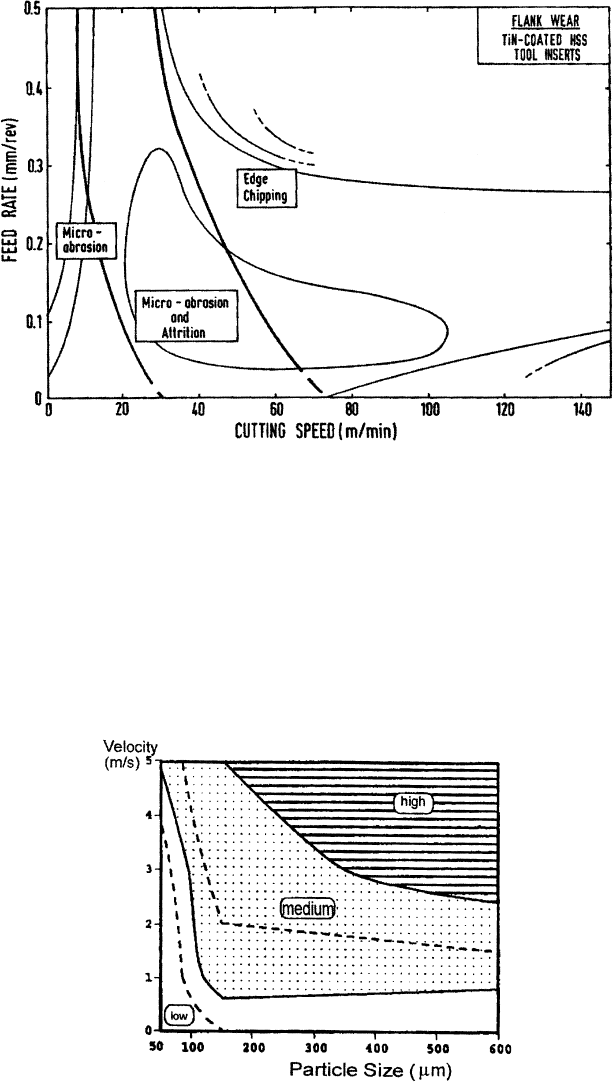
Figure 3.81 shows the first wear map that was developed to illustrate the wear
map concept (109). This map is one proposed for unlubricated or dry sliding between
steels, using normalized pressure and normalized velocity as the axes. In it the bound-
aries between regions of different wear mechanisms are identified, as well as the locus
of pressures and velocity conditions for a constant normalized wear rate within those
regions.
Figure 3.87 Wear map for flank wear of Ti-N coated steel tools, identifying regions of different
wear behavior. These regions are superimposed on those used to identify acceptable performance
(see Fig. 3.86). (From Ref. 167, reprinted with permission from Elsevier Sequoia S.A.)
Figure 3.88 Example of wear maps used to characterize erosion. This type of map is referred to as
velocity-particle size wastage maps. Axes are particle velocity and particle size. (From Ref. 164,
reprinted with permission from Elsevier Sequoia S.A.)
Copyright 2004 by Marcel Dekker, Inc. All Rights Reserved.

Another example of a wear map is the contour wear maps developed for 440C stain-
less steel for use in high-pressure oxygen turbopumps, shown in Fig. 3.82 (163). In these
maps contour lines of constant wear rate are plotted. For these applications, it was desir-
able to characterize wear behavior in terms of three operating parameters, load, speed, and
ambient temperature. To accomplish this, wear maps were developed for different combi-
nations of these parameters, as illustrated in the figure. In this case, the wear map can be
thought of as a three-dimensional wear space with axes of load, speed, and temperature,
where surfaces of constant wear rate can be identified. The two-dimensional graphs can
then be thought of as planes in that space and the contour lines are the intersection of
those planes with these surfa ces.
A less complex wear map than these two examples is shown in Fig. 3.83. In this
case load and speed are the operating variables of interest (168). This wear map is an
example of a wear mechanism map. In this map, three regions of diff erent wear
mechanisms, each with a characteristic order-of-magnitude wear rate, are identified.
These regions were identified by physical examination of the worn surfaces and wear
rate determination.
Wear transition maps are illustrated in Fig. 3.84. In this case, ambient temperature
and speed are the axes (165). In this map, three different regions of wear behavior are iden-
tified and correlated with different ranges of a wear coefficient for a ceramic slider. In this
tribosystem, wear behavior can be correlated to flash temperature and isothermal contours
for flash temperature are also plotted on the map. For this tribosystem, the three different
Figure 3.89 An example of the types of wear maps used to characterize erosion. This type is
referred to as materials performance maps. In these, the different regions are used to identity wastage
conditions for individual materials. In this particular map, the various shaded regions are regions of
low wastage for the individual materials. The clear region is a region of medium wastage for all the
materials. (From Ref. 164, reprinted with permission from Elsevier Sequoia S.A.)
Copyright 2004 by Marcel Dekker, Inc. All Rights Reserved.

wear regions are a result of differences in the formation of tribofilms on the surface of the
ceramic, as shown in Fig. 3.85. In region I, there is no evidence of transfer and a tribofilm
is not formed. In regions II and III, higher flash temperature promotes adhesion of tool
steel wear particles to the ceramic surface. In region II, there is partial film formation.
In region III, the film is more uniform and extensive.
Wear maps are also used to characterize tool wear and to determine optimum oper-
ating conditions for least tool wear (162,166,167,169). Example of a wear rate map used
for this purpose is shown in Fig. 3.86 (167). In this case, the axes are feed rate and cutting
speed. The boundaries of the regions are based on wear rate. Mechanism information can
also be placed on the map to provide a wear mechanism map. This is shown in Fig. 3.87,
where three regions of different dominant mechanism are identified. It is can be seen in this
map that the least wear region includes two different mechanism regions. With tools, such
maps are used to characterize both flank wear, as illustrated in the figures, and crater wear
(169).
The use of wear maps in solid particle erosion is illustrated in Figs. 3.88, 3.89, and
3.90. Three different types of wear maps are used (164). One is referred to as wastage maps
and the axes are generally particle size and velocity. Figure 3.88 is an example of this. In
this case, the maps identify regions of high medium, and low wastage rates, which were
based on the depth of wear, x, in a standard test. High wastage rate was equivalent to
x 8 mm; medium, 4 mm x < 8 mm; low, x 4 mm. These levels were based on the
approximate levels of wastage that can typically be tolerated in a fluid bed conveyer.
Material performance maps are developed from this by overlaying the wastage maps
obtained for different materials. In this case, it was for diffe rent metal matrix compo-
Figure 3.90 An example of four-variable wear map used to describe erosion behavior. This map is
used to characterize wear behavior in terms of wear mechanisms and use erodent size, erodent velo-
city, temperature, and material composition as parameters controlling the wear. (From Ref. 164,
reprinted with permission from Elsevier Sequoia S.A.)
Copyright 2004 by Marcel Dekker, Inc. All Rights Reserved.
